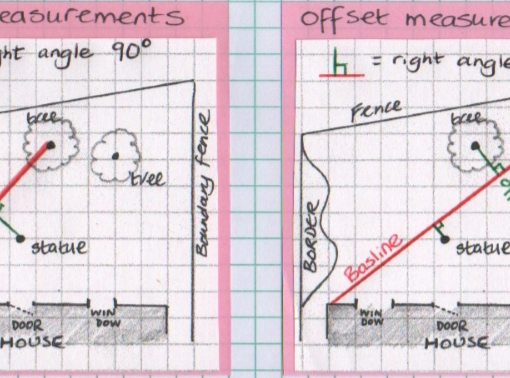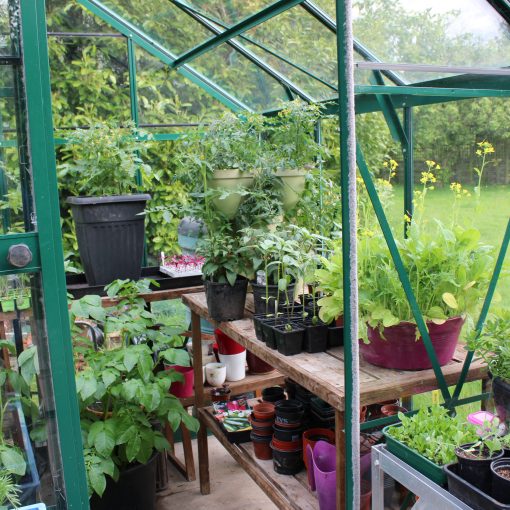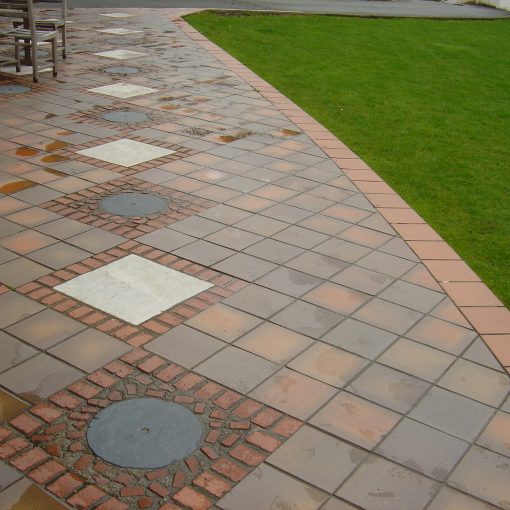This blog was originally written for the old syllabus and relates to R2102 and R2114. The new syllabus has a new section entitled ‘Bulk constituents for growing media’ (Unit 1 Topic 3 Element 5) which has learning outcomes such as understanding the properties of peat, forest residue (bark and chipped wood), loam (John Innes mixes), grit and vermiculite so you can find lots of relevant information here for the new level 2 theory qualification. Refer to the learning outcomes in the new syllabus.
Once you understand the ingredients that make up different types of growing media you can make up your own compost recipes which will save money as well as preserving special peat habitats.
Prefer to watch a video instead of reading? Skip to the end to watch me talking about growing media ingredients.
Introduction
Growing media is a term which means a mixture of materials in which plants can be grown. It is a term more often applied to containerised plants because a growing media is usually more processed compared to garden soil. Examples of growing media can be home-made leaf mould which could be used for seed sowing after being sieved, a bag of John Innes number 2 loam based potting compost or a bagged organic compost made from decomposed wood fibre. Module R2102 (plant nutrition and the root environment) covers different types of composts (bought or home-made) that can be used to improve garden soil but this is not covered here, we are just focusing on growing media used in containers. When we evaluate the benefits and limitations of different types of growing media we are assuming containers are positioned outside or under glass.
Learning Outcomes
This topic (Growing media) is found in two modules and here are the learning outcomes to keep us focussed:
R2102 (Plant nutrition and the root environment)
4.1 Explain the considerations required when growing plants in containers. Restricted root volume, water retention & supply, drainage, stability of compost materials, nutrients, partial sterility, weight/density. State the limitations of using soils in containers.
4.2 Describe a range of compost types. To include: peat based, peat free (coir, composted green waste, composted bark), ericaceous, loam based, seed compost, potting compost, multi-purpose compost. Describe ONE NAMED situation to illustrate the use of each compost type. Identify the environmental implications of peat in growing media.
R2114 (Understanding protected environments and their use in plant cultivation) 7.2 Describe the choice of suitable containers and growing media for house plants. To include: management considerations and visual appeal of containers; drainage, nutrients and water retention in composts and hygiene.
Factors to consider when growing in containers:
1. Root growth is restricted. Roots can only grow within the confines of the pot and if a plant become pot bound, where all you can see is a dense mat of roots when you take it out of the pot, it will be under stress. Water will not penetrate the growing media if it is packed with roots and nutrients may be lacking.
2. Water retention & supply The growing media should have good water holding capacity. The only water source is the gardener when growing in a greenhouse, and if situated outside, rainwater may run off the leaves and not penetrate the root zone. Once water supply is low, the plant cannot access more. The media must retain water that is accessible to the plant. Larger volumes of soil retain water better than small volumes. Amendments may aid water retention e.g., water retaining granules or vermiculite. Always leave space at the top of the pot for watering (ie don’t fill to the top with compost).
3. Drainage Media must be free draining, else it will become saturated and roots will die (as a consequence of a continued anaerobic environment). Adapted containers, eg old recycled tin cans, must have sufficient drainage holes. Don’t let media dry out completely as then it is hard to re-wet. In a container, free drainage and aeration are naturally impeded by the pot walls.
4. Air space Growing media should have good AFP (air filled porosity). Air filled porosity is the percentage of its volume that is air after being saturated with water and allowed to drain freely. (means it will have good drainage too) It is difficult to maintain sufficient water availability whilst ensuring sufficient gas exchange. The media must have large pore spaces that won’t collapse over the period of time the plant will spend in the container.
5. Stability of compost The media must have a good, stable structure so that roots can anchor and the medium does not ‘slump’ and become airless. It must retain its physical properties when inorganic fertilisers are added or when it is mixed with other ingredients and be able to withstand varying degrees of watering.
6. Nutrients Roots can only access the nutrients that are available in the container and can’t reach further afield in search of nutrients, compared to plants in borders. There is the challenge of supplying a large amount of nutrients dissolved in a small amount of water without scorching of the roots and overdosing. Incorporating slow-release fertiliser granules into the planting medium before planting is a way to ensure nutrients are gradually available to plant roots. Liquid feeds are another alternative as they are in solution, fast acting and if supplied at the correct dilution rate are effective. As well as lack of nutrients it is also easy to over feed. Too much nitrogen can produce ‘soft’ growth that is vulnerable to pests and diseases.
7. Partial sterility Partial sterility (no growing media can be totally sterile) means that most pathogens and weed seeds are killed off during processing which is particularly important for seed sowing growing media. However, there are also beneficial bacteria and fungi in garden soils and these will not be present.
8. Weight and density Growing media which contains loam such as John Innes mixes, are heavier than those which are made of just decomposed organic matter. This is useful for making large pots more stable and less likely to blow over, but they can also become compacted over time.
9. Root disturbance Choosing the right container may minimise the need to transplant as often which will cause root disturbance. Root disturbance will reduce plant growth as it recovers from the potting on process. Plants which have deep tap roots do not like root disturbance e.g. Lathyrus odoratus (sweet pea), so these are grown in long pots.
10. Type of compost Must be appropriate to the situation e.g., nursery sales of annual bedding will not require high nutrient potting compost. Cactus compost is free draining.
11. Correct size of container A container that is too small means plants may have to be transplanted before they are ready, or overcrowding may lead to damping off disease of seeds and seedlings. Too large a container is a waste of compost and also the plant may not thrive due to a ring of soggy compost around the roots which is saturated and does not allow oxygen to reach the roots. This is why plants are gradually potted on in stages rather than going from a small to a large pot.
12. Shape Square containers can be harder to fill properly to the corners but they fit together better when lots of plants are together on a bench.
13. Material of container Clay (Terracotta) is porous, plastic is not. Clay pots can dry out quicker than plastic but plastic has environmental impact.
14. Repotting/top dressing Permanent plantings will need repotting or top dressing with fresh growing media to encourage aeration and healthy root growth. Repotting is when the plant remains in the same sized pot but is removed, old compost is scraped away and replaced with fresh compost.
15. Pests Vine weevil is a pest which quickly become established in large numbers in growing media. Sciarid fly can be a problem with certain types of composts when grown under protection.
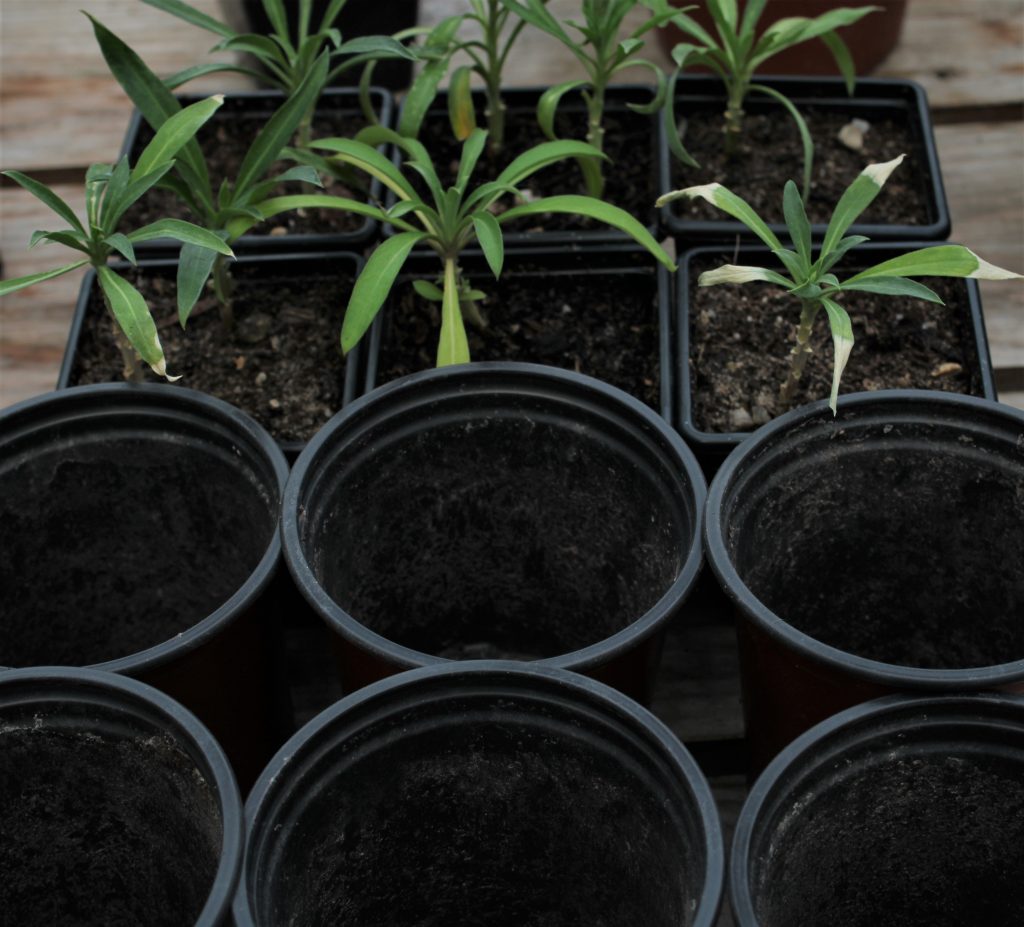
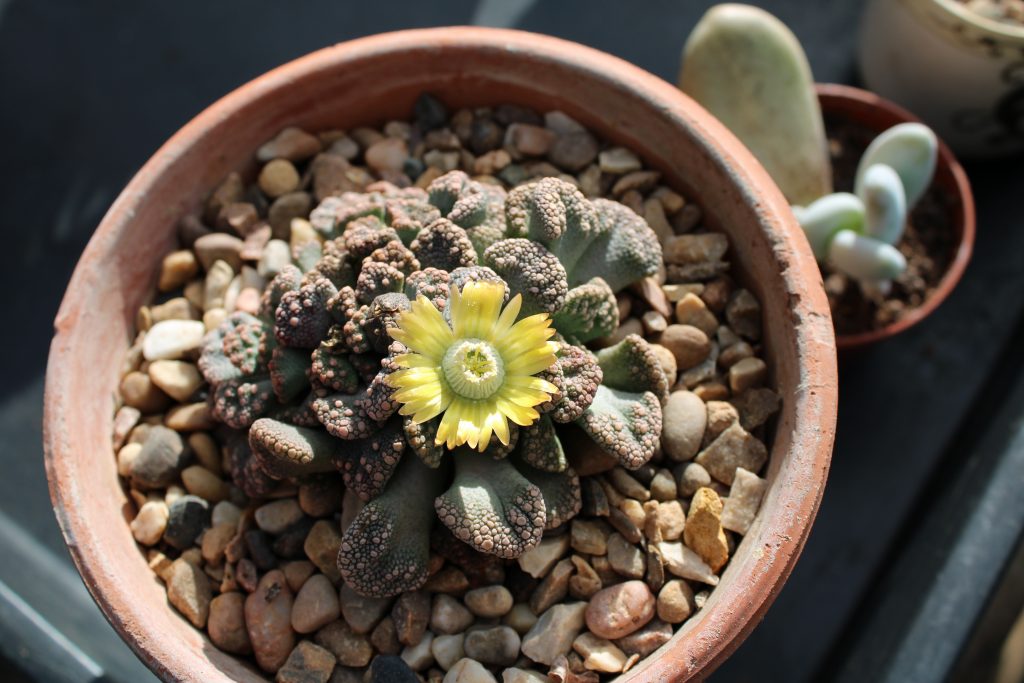
Why shouldn’t we use garden soil for containers? – Garden soil is not suitable for containers as its structure cannot be maintained against repeated wetting and drying. The pore spaces collapse, reducing aeration and drainage. In addition, containers do not have the factors in place to improve or re-instate structure, such as worms and other soil biota. – The fertiliser content is not known. – The garden soil may have the incorrect texture/structure for growing particular plants e.g. it may be a heavy clay soil type which would be unsuitable for Lavandula angustifolia (lavender) – Garden soil may contain pathogens in the form of bacteria and fungi. – Garden soil may contain pests such as vine weevil. – It will contain weed seeds – It may lack organic matter – The pH is not known – Garden soil may also be contaminated. E.g. salt spread in snow conditions or excess fertilisers which have washed down from other areas of the garden. The soil could also be contaminated due to industrial waste, a leaking oil tank etc.
Advantages of using growing media rather than garden soil – Plant specific mixes are available to buy or make at home. – e.g. gritty loam for
cacti, ericaceous media for acid loving plants, fine organic compost for seed
sowing. – Partially Sterile – no weed seeds or pathogens – pH is known – Nutrient content is known – Water retaining granules can be added – It is stable and uniform
Make your own growing media or buy it in a bag?
Make your own – The home gardener can make up different growing media for different purposes. Starting off with the bulky matter such as garden compost or leaf mould which has been sieved to an even consistency. The gardener can then make different recipes, depending on the plant being grown by adding fertilisers, additives that change the pH, perlite, sharp sand or water retaining granules for hanging baskets. Home-made composts are not sterile however and depending on how they are made, may or may not contain viable weed seeds and pathogens. While it is more sustainable to make your own growing media, the nutrient levels and pH can vary, and for seeds and young seedlings the level of nutrients is very important. One very important advantage is that it will be peat free. We will talk about peat in more detail later.
Buy it in a bag from a garden centre – Buying bagged ready-made growing media is a much more reliable way to guarantee the nutrient levels, water holding capacity, sterility and texture although I have opened some bags of compost which look like dust or hair in texture. There can be a vast difference between composts from different retail outlets and the same compost from the same retailer can vary from year to year. The organisation ‘Which’ tests composts regularly and publishes the results. Here is the link which may not show all the information if you are not a member. https://www.which.co.uk/reviews/compost/article/best-compost-ahUv44C6lrR5#getting-the-best-from-compost As I am member I can tell you that a February 2021 report recommended Sainsbury’s peat free multipurpose compost which was tested all through last year. There were others that scored higher but the top one contained 80% peat so I won’t mention that one, for reasons covered later.
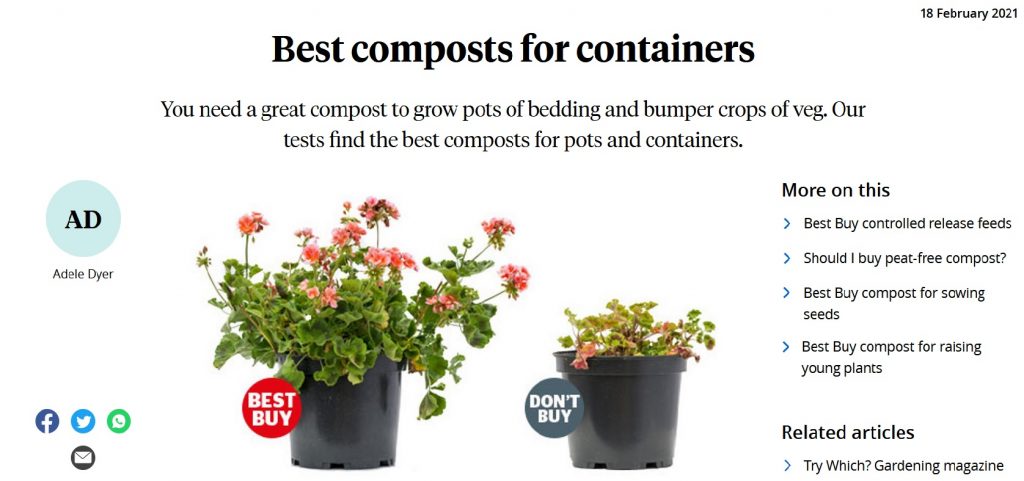
This is a screen shot from the ‘Which’ website which demonstrates clearly how the quality of compost can influence plant growth.
Describe a range of growing media (compost types ) Here we are talking about growing media which is bagged and has been processed elsewhere. Bagged growing media can be soilless (organic mixes) or soil based (John Innes mixes)
Soilless or Loamless composts
Loamless composts are made from organic matter which is peat or peat substitutes. Peat, until recently, has been the main ingredient of container composts as it is uniform and stable with a good WHC (water holding capacity) and AFP (air filled porosity.) Peat free substitutes are now the best choice for sustainability reasons. Loamless composts can be bought as bagged compost under the following titles:
Multipurpose composts – for a wide range of purposes – fine enough for seeds and a balance of nutrients that suit most plants up to about 4 weeks. Generally have lime added so suitable for a wide range of plants but not for acid loving plants (calcifuges). Controlled release fertiliser can be added to provide nutrients for potting on larger plants.
Seed & Cuttings composts – a finer grade of compost specifically for seeds and cuttings. A short term compost due to low nutrient levels.
Potting composts – a coarser grade of compost, often can be used as a potting-on medium for larger plants in containers. Higher in nutrients for long term nutrition.
Ericaceous composts – specifically designed for calcifuges (acid lovers) such as Blueberries or Rhododendrons grown in pots. The pH will be in the range 4.5-5. What are loamless composts (organic composts) made of ? Peat There are still many composts made from peat. This is because peat performs well in containers. Even bags which have a large label on them saying ‘reduced peat formula’ can still contain 70% volume of peat. BUT should we be using peat? Absolutely NOT.
The Peat Debate
What is peat? Peat is partially decomposed organic material formed in waterlogged soil, in bogs and fens. Horticultural peat is made of mosses, particularly sphagnum moss which has not decomposed fully because of lack of oxygen. It is pathogen and weed free, uniform in texture, stable, acidic and contains very little nutrients. It can easily be made more alkaline by adding lime and nutrients can be added. Therefore, being acidic and low in nutrients is a good thing from a processing point of view as it can easily be adjusted to make different types of compost. One drawback of peat is that if allowed to dry out completely, it is difficult to rewet, as well as the MAIN reason – sustainability issues associated with harvesting of peat.
Why shouldn’t we use peat?
1. Government legislation. In 2011 the government set a target that by 2020 all bagged growing media sold to home gardeners would be peat free and professional growing media would be peat free by 2030. In 2017 a sustainability scoring system was implemented to encourage a more responsible approach to compost. Compost is scored for waste generated, renewability, habitat and biodiversity, pollution during processing and energy and water used. Recently (2021) a new target to be 100% peat free by 2025 has been set as the 2020 target has not been acheived.
2. Peat extraction is not sustainable – we will run out if we keep extracting it as it takes 1 year to make 1mm of peat (Charman 2002)
3. Peat lands are wildlife habitats of rare value.
4. There is loss of archaeological remains which stay well preserved in peat.
5. Carbon is no longer locked up and leads to increased greenhouse gas (CO2) emissions, a cause of climate change.
6. Peat absorbs water, so extracting it can result in flooding and affects the level of the water table.
Reasons why peat is still used in commercial horticulture
Growers will argue that nothing is as reliable as peat. There is a long history of plant production using peat so using peat substitutes is a big risk for growers to take, because commercial production of containers on mass, relies on a uniform, stable, reliable growing media. If a peat substitute like green waste is used, the nutrient levels can vary in different batches which will lead to inconsistencies. Peter Seabrook has argued that we will deprive Lithuania of its major industry and that peat use is sustainable if we reinstate high water levels. Personally I think we should go peat free. This is a good website if you want to learn more about peat habitats. https://www.moorsforthefuture.org.uk/our-purpose/habitats-for-wildlife/boggy-facts-and-figures
Peat substitutes Peat substitutes include green waste (municipal waste), coir and composted bark or wood fibre (also called forest residue in the new syllabus). Bagged growing media may be blends of these materials. Some materials can be quite coarse and require sieving if sowing seeds.
Coir A waste product from coconut husks made up of coarse fibre and dust. Mainly from Sri Lanka. Better water retention than peat (Good WHC). Re-wets easily. Does not touch the soil so no soil born diseases. Can be very dusty and quality of texture varies. Usually doesn’t need sieving. High carbon footprint as travels far. A high water footprint as a lot of water is used to process it and in Shri Lanka water is a very scare resource. Can buy as a dry compacted brick and then add water, so easy to carry and portable. pH neutral, low in nutrients. Here is a really good (but long 20 mins) video of an American guy talking about the pros and cons of peat versus coconut coir. https://www.youtube.com/watch?v=MvYZdxVipAo

Composted green waste
This is Council produced organic waste of varying quality. Usually hot composted so weed seeds and pathogens are destroyed. Usually nutrient rich, so no good for seedlings. Some councils do not monitor quality when they make it so it varies greatly. Weeds, pests and diseases are present if not heated enough. Recycling so sustainable. Contamination with glass, plastic and fragments of undecomposed matter may be found. Higher bulk density compared to peat and coir – a denser consistency. Often used for blending with sand and loam to make potting media for vegetable plants as high in nutrients. pH varies depending on type of plant material which is broken down. In January when lots of Christmas trees are composted it can become more acidic. A good article analysing composted green waste: https://verticalveg.org.uk/municipal-compost-is-it-a-good-thing/
Composted bark and wood fibre (forest residue)
This is one of the most common peat alternatives. Texture varies enormously and can be lumpy (coarse texture) if badly processed. Sieving can help for sowing fine seed. Moisture retentive but that also depends on texture. Good drainage properties. Low nutrition. Light weight. Tends to be acidic. Recycled and sustainable. Difficult to rewet once dried out.
Further reading:
An article discussing different peat replacements: http://www.wlgf.org/Replacements%20for%20peat%20in%20horticulture.pdf
Loam-based /soil based composts (a range of John Innes composts)
As we covered earlier, garden soil is often not suitable for container growing for various reasons. John Innes is a loam based potting recipe developed at the John Innes institute. Traditionally John Innes is made from sterilized loam with added peat and sand plus other ingredients depending on its purpose. The peat helps to retain water and the sand aids drainage. Nowadays peat may be substituted with a peat free additive so it is best to check the ingredients on the packaging before purchase. If purchased as a John Innes compost the growing media will not contain pathogens or weed seeds. As the bulk of the medium is made from rock particles (Sand, silt and clay) the medium is heavier which is useful for pot stability with taller plants or for those in windy locations. Soil-based medium is also a bit more forgiving when it comes to water and fertility. They tend not to dry out as fast, and they also tend to hold on to nutrients longer.
John Innes Composts There are various John Innes formulations designed for different purposes:
JOHN INNES SEED COMPOST – the traditional mix for sowing almost any type of seed, with sufficient nutrient for early development. May also be used for rooting soft cuttings. A short term compost due to low nutrient levels.
JOHN INNES POTTING COMPOST No.1 – for pricking out or potting-up young seedlings or rooted cuttings. This composts has a carefully balanced nutrient content to suit most young plants.
JOHN INNES POTTING COMPOST No.2 – for general potting of most house plants and vegetable plants into medium size pots or boxes. Contains double the amount of nutrient in JI No 1 to suit established plants.
JOHN INNES POTTING COMPOST No.3 – a richer mixture for final re-potting of heavy feeding vegetable plants and for mature foliage plants and shrubs in interior planters or outdoor containers. No 3 Compost is also suitable for vigorously-growing plants such as tomatoes.
JOHN INNES ERICACEOUS COMPOST – A recently developed product that is suitable for use with ericaceous or ‘lime-hating’ plants.
Technical data sheet for John Innes growing media mixes: https://hta.org.uk/uploads/assets/uploaded/14cfae5c-76dd-4328-83828dd639a70d3f.pdf
Summary: What are the advantages / disadvantages of loam based growing media (John Innes) compared to loamless or organic growing media?
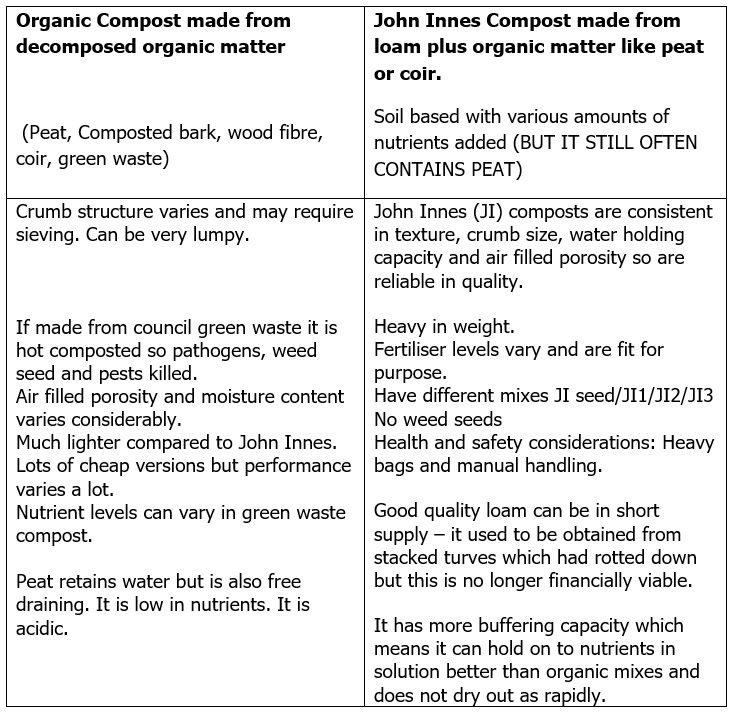
Personal preferences
Growers get used to using specific mixes or adding their own additional ingredients to John Innes mixes or organic mixes. You could say it is a bit like baking. Of course it also depends what plant is going into the mix. My colleague always likes to add extra sand to the mix and I much prefer loamless mixes because when I used John Innes mixes in the past I tended to overwater them. My personal favourite is Melcourt Sylvagrow multipurpose compost. I find it is great for seed sowing (does not require sieving) but also when used for potting on, the plants seem happy for quite a while before having to feed them or repot again. I went to the garden centre to read the ingredients and the John Innes composts all contained peat rather than peat alternatives so that’s another reason to use peat-free organic composts.
Other ingredients which can be added to growing media
Perlite Is derived from volcanic rock which is mined, then heated to extreme temperatures requiring a high energy input. As trapped moisture is driven out, it expands to many times its original volume creating a white light-weight product which is then processed into granular particles in various sizes. It looks like white rice krispies. Perlite does not have the moisture and nutrient holding capacity of vermiculite. It is added to potting medium to improve drainage and aeration and is used to create an open potting media for cuttings.
Summary: · High energy required for manufacture · Light weight, no pests and disease · Increases air filled porosity (AFP) of potting media · Decreases water holding capacity (WHC) of potting media by creating large pore space and therefore assisting with drainage. · Good insulation properties for storing Dahlia tubers for example · Sterile · Used perlite can look unsightly when tipped onto borders.
Vermiculite Is a naturally occurring mica mineral (rock) that is mined, heated and crushed to create multi laminated particles, a high energy process. It is often added to growing media for seed sowing because it maintains air spaces to assist drainage and the laminated particles create a large surface area on which moisture can be trapped which helps retain water and nutrients. Available in coarse, medium and fine grades, it is valuable as a covering after sowing because it insulates the seeds, keeps them in contact with the moist compost and does not impeded emergence. Used to aerate composts and help moisture retention.
Summary: · High energy required for manufacture · Light weight, no pests and disease · Increases air filled porosity (AFP) of potting media but not as much as perlite. · Increases water holding capacity (WHC) of potting media as wafer-like layers hold on to water. · Contains some nutrients – potassium and magnesium · Sterile · Often seen in multipurpose compost to improve water holding capacity. · Good as a seed covering.
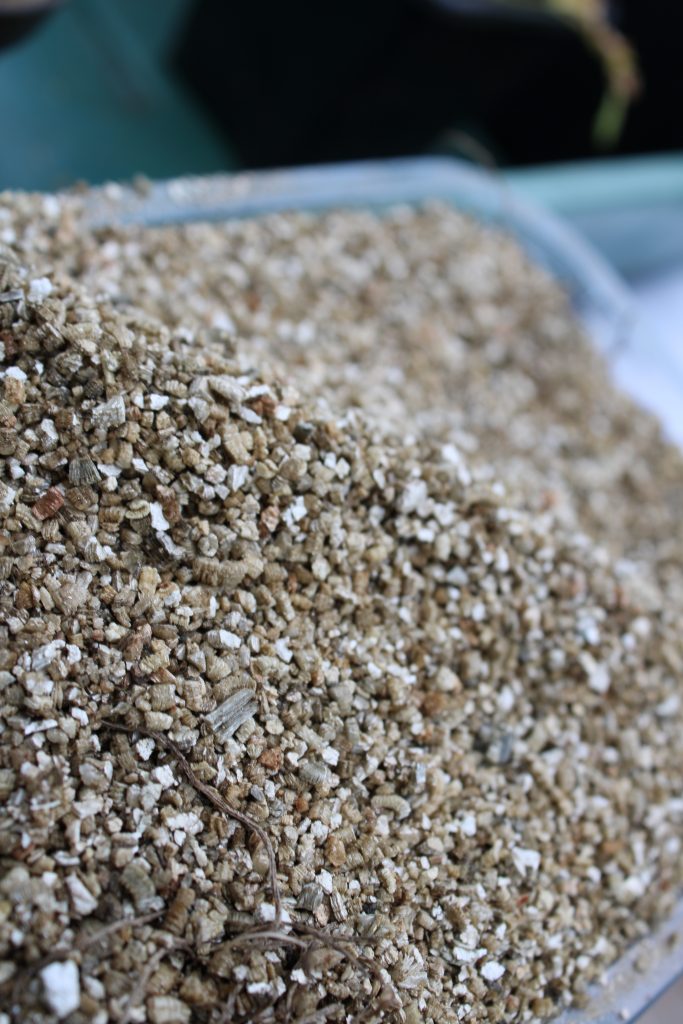
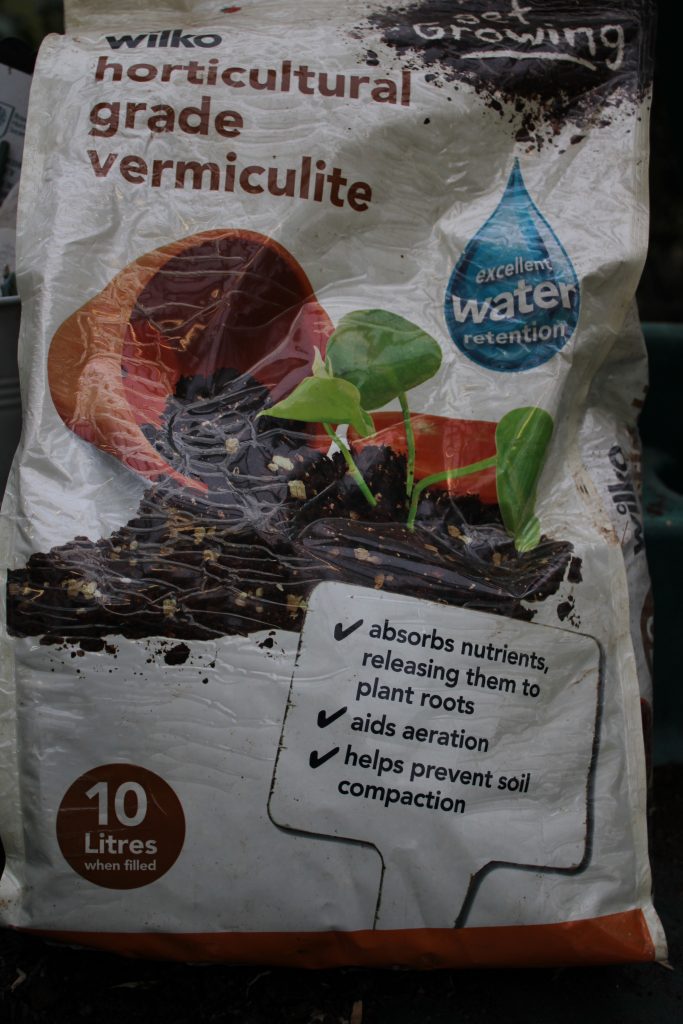
Horticultural sharp sand Horticultural grade means that there are no toxic impurities in the sand. Sharp sand is a mined rock made up of small particles under 3mm in size. Compared to other types of sand, sharp sand is angular in shape and coarse -particles are larger than other sand types. Added to mixes to increase drainage and increase air filled porosity.
Horticultural grit This is a mined rock consisting of a mix of particle sizes up to 5mm. It can be incorporated into the growing medium to increase drainage (decrease water holding capacity) or as a top dressing to reduce evaporation from the soil surface and also for ornamental purposes. It also adds weight to the compost. This can also be added to composts for rooting cuttings which require a high air-filled porosity.
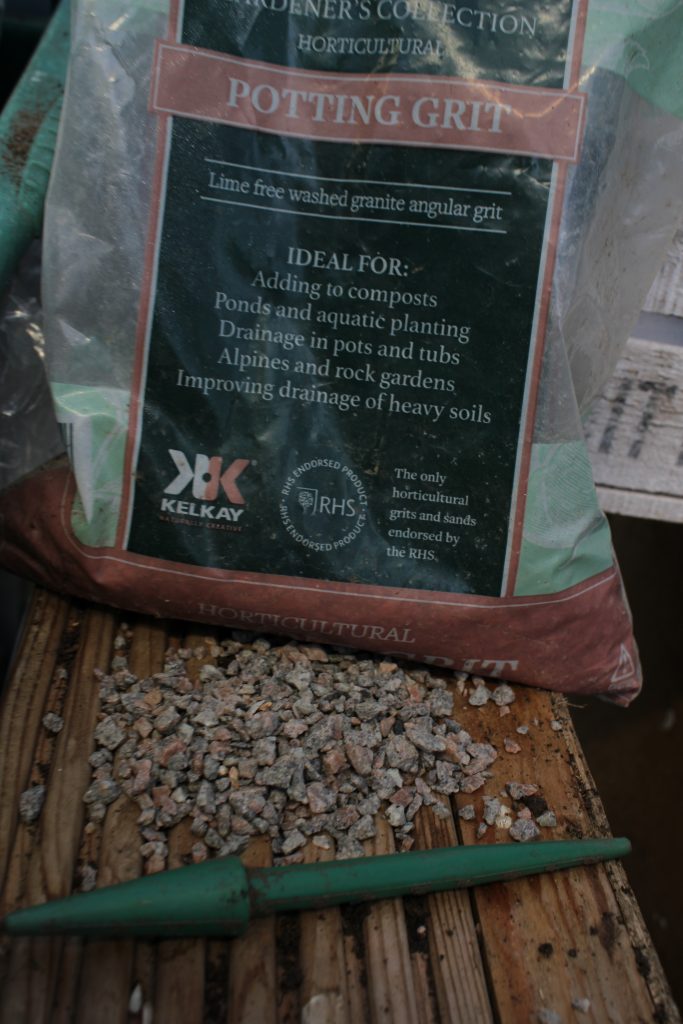
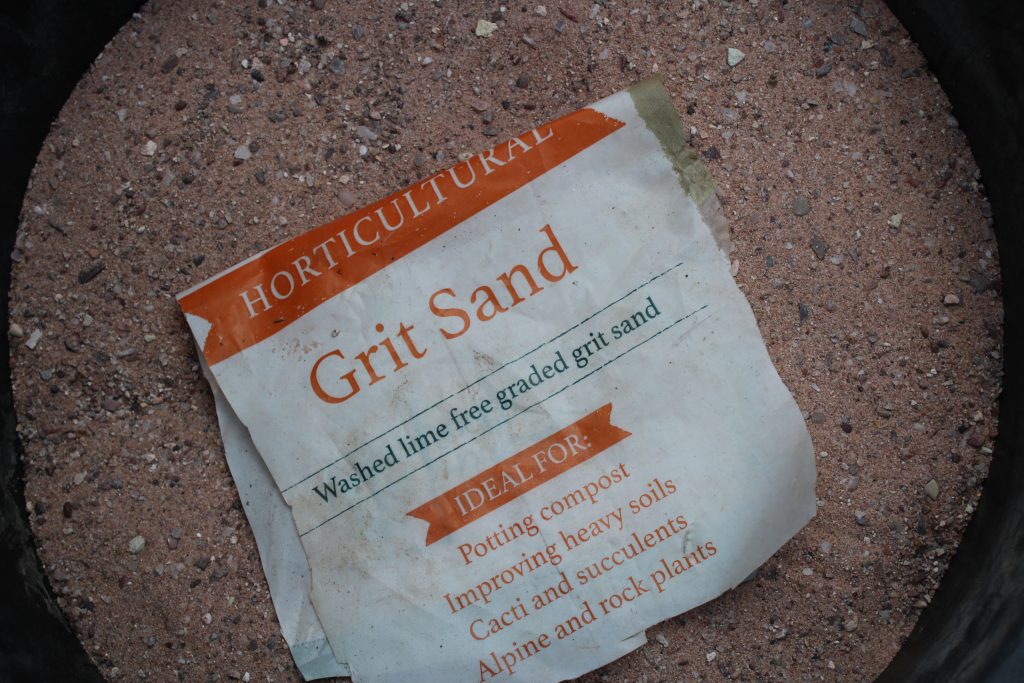
Sharp sand, grit sand and grit Summary
These need to be horticultural grade so excess salts are removed. Mined minerals which are crushed to give small particle sizes. Increase drainage and decrease water holding capacity. Increase air filled porosity. Do not hold on to water or nutrients. Make container heavier. Used for rooting cuttings, and for potting on cacti and succulents which require sharp drainage. Grit can be used as a decorative top dressing.
Controlled release fertilisers
These fertilisers are made up of little ball bearing-like granules which are coated with a porous material such as sulphur or synthetic resin. As the temperature and the moisture in the compost increase, more nutrients are released which corresponds with the increase in plant growth. These fertilisers are added once and can sustain the plant for months. This is a time saving way of feeding containerised plants. These can be added to a multipurpose compost for potting on more mature plants which require higher nutrient levels.
Water retaining gel granules
Some composts sold specifically for hanging baskets and Summer containers contain water retaining gel granules which are mixed in with the growing medium to help increase its water holding capacity for longer periods of time. The RHS website states that the gel does break down over time which can take 5 years or longer. More information here: Water retaining granules RHS
Exam hints and tips
Although the general consensus is that we should be using peat free growing media, it is still listed in the syllabus (and is still in a lot of composts) so you cannot ignore it. Know its properties just like the other types of organic growing media.
I think the rest is covered above.
Here is a video summary of most of the key points: Please note I put R2114 on the board behind me, but this is very relevant to R2102 module too.
https://www.youtube.com/watch?v=aZwYu3HEvHQ


